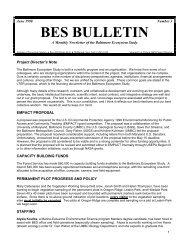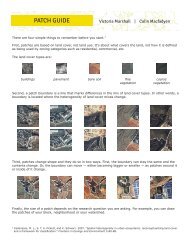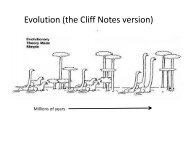Investigations in Urban Soils - Baltimore Ecosystem Study
Investigations in Urban Soils - Baltimore Ecosystem Study
Investigations in Urban Soils - Baltimore Ecosystem Study
Create successful ePaper yourself
Turn your PDF publications into a flip-book with our unique Google optimized e-Paper software.
5. Optional: If worms have not been identified, ask the scientist if he/she would be<br />
will<strong>in</strong>g to have them identified <strong>in</strong> the laboratory and return the results. (See<br />
example of worm identification results, Student Work Sample #4.)<br />
Part 4 – Assessment<br />
Days 12 – 16: Report to Scientist<br />
Students prepare reports for scientist on earthworm distribution and habitat characteristics <strong>in</strong><br />
urban ecosystems. They also predict the outcome of future <strong>in</strong>vestigations based on their<br />
f<strong>in</strong>d<strong>in</strong>gs.<br />
Materials:<br />
As needed<br />
Preparation:<br />
1. Select a format for student report<strong>in</strong>g – poster, written report, oral report, etc. Click<br />
on a l<strong>in</strong>k to see an example of a brief essay assignment (Student Handout #8), or<br />
an extended report assignment (Student Handout #9). Student teams can work<br />
together on decid<strong>in</strong>g what belongs <strong>in</strong> a formal report, and then each can write<br />
one section.<br />
2. Enlist the aid of the writ<strong>in</strong>g teacher to re<strong>in</strong>force the writ<strong>in</strong>g process for written<br />
reports.<br />
3. Instead of each student writ<strong>in</strong>g a full report, teams of students can write small<br />
sections of a full report and comb<strong>in</strong>e all sections with graphs and photos for a<br />
collective poster. See an example of a cooperative report (Student Work Sample<br />
#5).<br />
4. If giv<strong>in</strong>g presentations, try to arrange for the scientist, school adm<strong>in</strong>istrators, and<br />
parents to attend.<br />
Procedure:<br />
1. The f<strong>in</strong>al report may take any number of forms. Based on the ability of your<br />
students, plan a reasonable f<strong>in</strong>al report. The f<strong>in</strong>al report should serve as a way<br />
for students to communicate their f<strong>in</strong>d<strong>in</strong>gs, a fundamental skill <strong>in</strong> science, and<br />
also an evaluation tool for you. The report creation and presentation stage is also<br />
ideal time to <strong>in</strong>vite a scientist to the classroom. The scientist might provide some<br />
suggestions on Day 12 about how students can present their f<strong>in</strong>d<strong>in</strong>gs. Or, you<br />
may decide on the report format as a class and <strong>in</strong>vite the scientist on the last day<br />
of the project.<br />
2. Suggested f<strong>in</strong>al reports:<br />
a. Assign each student a written report, such as an essay contest<br />
summariz<strong>in</strong>g results. See examples of satisfactory, good, and great<br />
essays (Student Work Samples #6, 7 and 8).<br />
Draft 2 - (9.28.04)<br />
<strong>Baltimore</strong> <strong>Ecosystem</strong> <strong>Study</strong> – <strong>Investigations</strong> <strong>in</strong> <strong>Urban</strong> <strong>Soils</strong><br />
page 35






